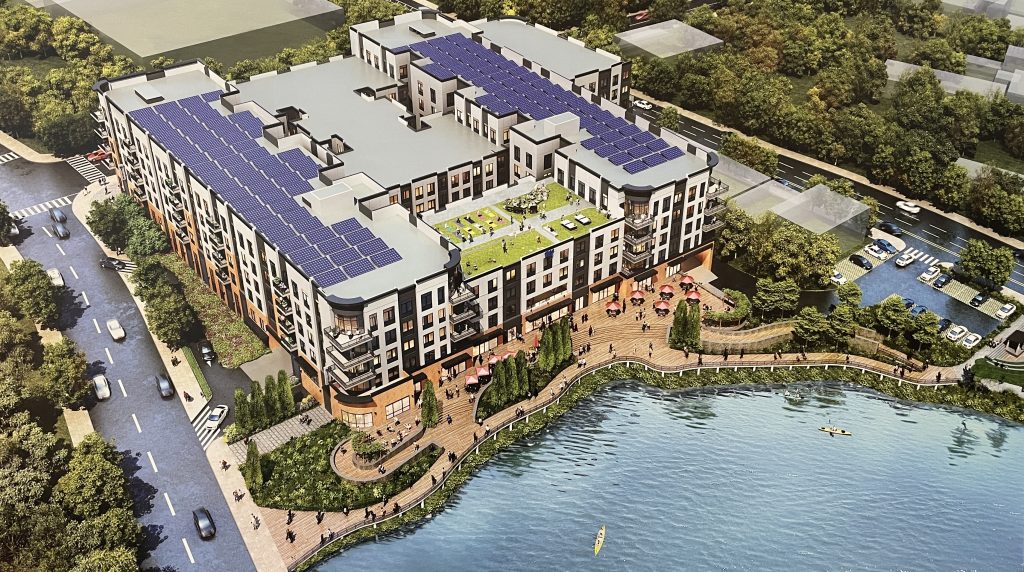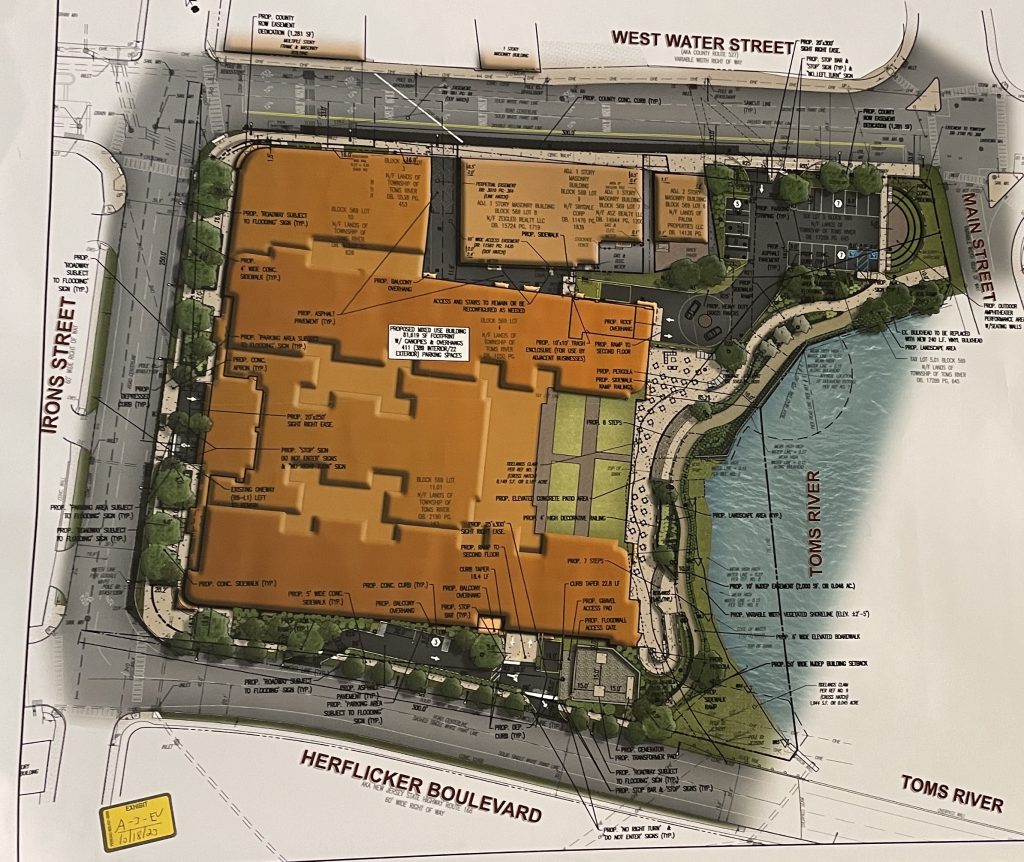Despite a number of impassioned pleas from a handful of objectors, the Toms River Township planning board on Wednesday night delivered a 6-0 vote in favor of paring down a previously-approved 10-story “twin towers” mixed use property in the downtown area to a six-story project that will reconfigure the site.
Testimony went on for nearly four hours in the marathon hearing, which included lengthy descriptions of discussions of the vision for the site, the construction materials slated to be utilized, site amenities, and the overall future of the downtown sector of the township.
Meridia at Toms River, as the project has been named by its developer, Capodagli Group, will now contain 281 residential units instead of 285 as originally approved, and 14,781 square feet of commercial space along a river-facing promenade, down from more than 16,000 that had been previously approved.
Attorney Robert C. Shea, representing the developer, said after the original approval was in-hand, Capodagli began work on its CAFRA permit, a state environmental clearance under the Coastal Areas Facilities Review Act that is a notoriously lengthy process. The state, he said, had concerns about the placement of some of the retail portions of the site as it was originally designed and suggested moving these to the second floor, which was a non-starter for the developer.
“It took almost a year to get a response from them as, obviously, it is a very sensitive area by the water,” said Shea. “We were notified by the DEP that there was about a 2,500 square foot retail area on the floor at Water Street. They would require us to move that to the second floor, which wouldn’t make sense to move retail up a level.”
Meanwhile, opposition to the size of the project was beginning to build in town.
“We wanted to have something that the township enjoyed and liked, so the conversations commenced,” he said, with Capodagli eventually settling on single building that would contain two floors of parking and commercial space, and four floors of rental units.
Architect Christiano Pereira said he envisions commercial space will be taken up by a combination of businesses that would serve the community as a whole, including retail stores, restaurant space, and day care services. The commercial portion will be built along a walking path that run the length of the riverfront at the site, near Water and Irons streets.
“We don’t know who will rent the space, but the idea is to create a beautiful promenade with a great number of active uses,” Pereira said.
The site will also include an amphitheater which will be available for use by local arts groups to promote downtown concerts and other events. Shea said there will be about $5.5 million of direct public infrastructure investments borne out of the project, which itself is an overall $70 million construction effort.
“Hopefully this project comes in, gets built, and is the linchpin for other projects,” he said.
Altogether, the complex will include:
- 281 total apartments
- 53 studios
- 145 1-bedroom units
- 38 2-bedroom units
- 22 2-bedroom affordable housing units
- Two 3-bedroom market rate units
- 21 3- bedroom affordable units
- 14,731 SF of retail space
- 333 parking spaces for residents
- 78 public parking spaces
Opposition
Several members of the public reiterated objections to the development, arguing it was too big for the space allotted – mainly a disused parking lot and the site of a former derelict, crime-ridden motel – and would transform the downtown sector of the township from a “village” to a “city.”
Downtown Toms River initially was developed as a fishing village where fishermen would unload their catches after returning from sea through the now-closed Cranberry Inlet. It was also once home to a thriving boat-building industry. The downtown area began a downturn after the 1970s and 1980s brought the Ocean County Mall, large retail plazas and strip malls to expanded highways. Now, the effort is focused on revitalizing the area and restoring the business community, which for years has consisted primarily of offices and commercial ventures that supported the county courthouse, making downtown largely vacant on evenings and weekends. Signs of life have appeared in recent years, however, with packed outdoor restaurant nights and a fledgling arts community that has sprung up. The debate, however, is how to draw people to the area in order to make the progress sustainable.
“This was supposed to have been a seaport look,” said resident Irene Watson. “‘The Village of…,’ that’s what I wanted to see. ”
Mark Mutter, a former mayor, attorney and township clerk who now serves as the township historian, asked the board to consider holding off on voting until a well-promoted town meeting could be held to re-examine the downtown redevelopment plan as a whole. He referenced the resolution of approval of the previously-approved 10 story complex to drive home the point that not enough consideration was put into the plan.
“In just five short paragraphs, the application by the developer in 2021 was put into a final resolution for a vote,” he said. “Five paragraphs for a project that would change Toms River forever. We can do better – you can do better. Think about the new plan, keep the public hearing open, and do what I did when I was mayor … and get the stakeholders to decide on our future.”
“There’s no going back from this,” warned resident Paul C. Williams, who is running a write-in campaign for a seat on the township council, though he stopped short of completely opposing redevelopment.
Williams did, however, voice concern that under the new plan, the top four floors of the structure would be wood-framed, whereas all 10 stories of the previously-approved structure were built on a concrete frame. Engineers representing the developer said the materials used to construct the building meet all fire codes, the the company worked with the township’s fire bureau to add more fire department connections, suppression systems and sprinkler outlets.
“If elected, and as I am aware that the township cannot simply terminate the plan that has already been approved, I would absolutely hold the developer accountable to the agreement and, should the developer default in the terms of the agreement, consider urging council members to join in having the township commence proceedings to terminate the agreement,” he wrote on his campaign website.
Support
A show of support for the project came from several members of the business community, including Mairin Bellack, director of the downtown Business Improvement District, a store owner and the proprietor of a new art gallery who said demand for a walkable downtown area with restaurants and entertainment is surging. During a recent “Night Out” event, she had 500 people walk through her gallery, producing thousands of dollars in sales of art. An influx of residents to the area would only increase the number of businesses willing to take a flyer on moving into what many see as an up-and-coming area.
Shea himself, who has served in leadership positions with the township’s Chamber of Commerce and whose office is located downtown, stated outright what many supporters of the project have held back: the troubled condition of the township’s waterfront.
“There are elements in that area that will be cleaned up as a result of this project,” he said, telling board members that after the summer – and after dark – it’s “not a place I would take kids.”
Indeed, it is not uncommon to find refuse from empty beer cans, to airplane bottles of liquor, to an occasional hypodermic needle found upon the unkempt riverbank.
“This is the opportunity to make it happen,” Shea said. “If it doesn’t, let me tell you, we’re going to be looking at a vacant parking lot for the next 40 years.”
A Final Decision
As expected, there was allusions to township politics strewn throughout the hearing, most notably the vicious primary battle between incumbent Mayor Maurice “Mo” Hill and Councilman Dan Rodrick, who ran his campaign on an anti-overdevelopment platform.
“The great silent majority of our town was not so silent back in June,” said Mutter. “You must know that the overwhelming majority of sincere township residents have concerns about the future of downtown Toms River and the height of the buildings in our downtown. Perhaps more thought would lead to more compromise.”
For supporters of the project, however, the reduction in height of the complex from 10 stories to six did represent a major compromise without sacrificing the public amenities that Capodagli has promised to build along the riverfront.
Ultimately, the board voted 6-0 to approve the revised site plan that would allow the six-story iteration of Meridia to replace the 10-story complex initially approved.
Shea said New Jersey’s rent unit occupancy rate stands at 97 percent, and demand will grow larger in Toms River as Community Medical Center expands a major medical residency program. Capodagli, he said, looks to have to entire residential portion of the complex occupied by tenants within 15 months of completion.

Advertisement

Ortley Beach & North Beaches
Landmark Ortley Beach Breakfast Spot Looks to Expand

Ortley Beach & North Beaches
‘Temporary’ 70-Foot Cell Tower on Route 35 in Ocean Beach OK’d to Return

Seaside Heights & Seaside Park
Beloved South Seaside Park Restaurant Will Remain Open As Developer Seeks to Demolish Block

Seaside Heights & Seaside Park
In Seaside Heights, A $50M Flagship Building Rises Over the Boulevard in a Famed Location

Police, Fire & Courts
Ocean County Sheriff Establishes Drone Command Center in Seaside Heights Amid New Video







